(Ken Silva, Headline USA) Nearly nine years after the fact, the Justice Department’s Inspector General has released a damning report on the death of Robert LaVoy Finicum, who was killed by law enforcement in January 2016 during an armed protest at the Malheur National Wildlife Refuge.
As has been widely documented, Finicum was killed under suspicious circumstances during the occupation of the wildlife refuge. The FBI and local law enforcement had set up a roadblock to stop Finicum and several other activists, and shot at his vehicle as he approached. Finicum got out of his truck with his hands in the air, but was gunned down by Oregon State Police anyway.

The FBI’s Hostage Rescue Team initially denied firing at Finicum, but agents were later caught engaging in a cover-up—removing bullet casings from the crime scene at the dead of night. The FBI was later determined to have fired at least two shots. One FBI HRT operator was indicted over the matter, but a jury acquitted him in 2018.
In his Tuesday report, DOJ-IG Michael Horowitz said he attempted to conduct his own investigation into the FBI’s conduct in the Finicum shooting, but that then-Attorney General Bill Barr blocked him from doing so.
“The OIG encountered a significant issue regarding its access to information in this matter,” he said.
Horowitz said he was allowed to polygraph two FBI HRT operators who were present at the scene of the shooting. However, Barr wouldn’t allow him to interview a third HRT operator, he said.
“The FBI routinely uses polygraph examinations in its administrative misconduct investigations, and the OIG’s request was identical to the polygraph requests that the FBI had previously approved for the first two FBI HRT operators,” Horowitz said.
“Nonetheless, the FBI denied that request following its receipt of a memorandum from then Attorney General William Barr stating that the FBI should deny the OIG’s request because of his belief that compelling the polygraph would not be consistent with FBI policy or appropriate under the circumstances,” he added.
“The FBI adopted Barr’s position in denying the OIG’s request. As the OIG noted in our report to the FBI following our de novo examination, the FBI’s denial of the OIG’s request was inconsistent with its usual practice and deprived the OIG of information relevant to our oversight responsibilities.”
Most of the remainder of the DOJ-IG report focused on the FBI’s “mishandling” of evidence. He recounted how local law enforcement assumed control of the crime scene because only two shell casings were initially found.
However, investigators later determined that at least eight shots were fired, only six by the Oregon staties. FBI aerial surveillance footage later showed FBI HRT personnel moving around the scene in the dark after the shooting—using flashlights to look under and around vehicles, examining the area near the roadblock, and appearing to pick up objects from the roadway in an apparent attempt to engage in a cover-up.
The FBI’s story about the cover-up is that its agents were looking for flash bang canister during its evening search—even though none were collected that night.
The DOJ-IG report debunked the FBI’s cover story, but nevertheless didn’t recommend any penalties for the agents involved. Instead, the DOJ-IG recommended new guidelines for how the FBI HRT handles “sensitive” evidence such as flash bangs.
The DOJ-IG report recommended that the FBI update its shooting incident policies for circumstances where the FBI participates in a law enforcement operation that results in a shooting involving another law enforcement agency; analyze whether and under what circumstances its policies permit identifying and removing sensitive items from a crime scene; and develop guidelines for identifying and removing sensitive items.
The FBI agreed with all of those recommendations.
Headline USA contacted Ammon Bundy, the leader of the Malheur National Wildlife Refuge standoff, for his reaction to the report. Bundy, who was arrested over the matter but later acquitted, reiterated his longstanding belief that his friend, Finicum, is dead because of the FBI.
“The FBI HRT caused the entire incident. They shot at the vehicle when the sheriff pulled us over causing Lavoy to flee. Then the FBI shot at the vehicle when Lavoy was driving. Then FBI agents continued to shoot into the vehicle after it was stopped—shooting my brother in the arm, (the bullet is still in his arm today),” Bundy told this publication.
“Then after it was all over the FBI secretly picked up the ammunition casings and lied in the reports and interviews about how many time the shot.”
Ken Silva is a staff writer at Headline USA. Follow him at twitter.com/jd_cashless.

